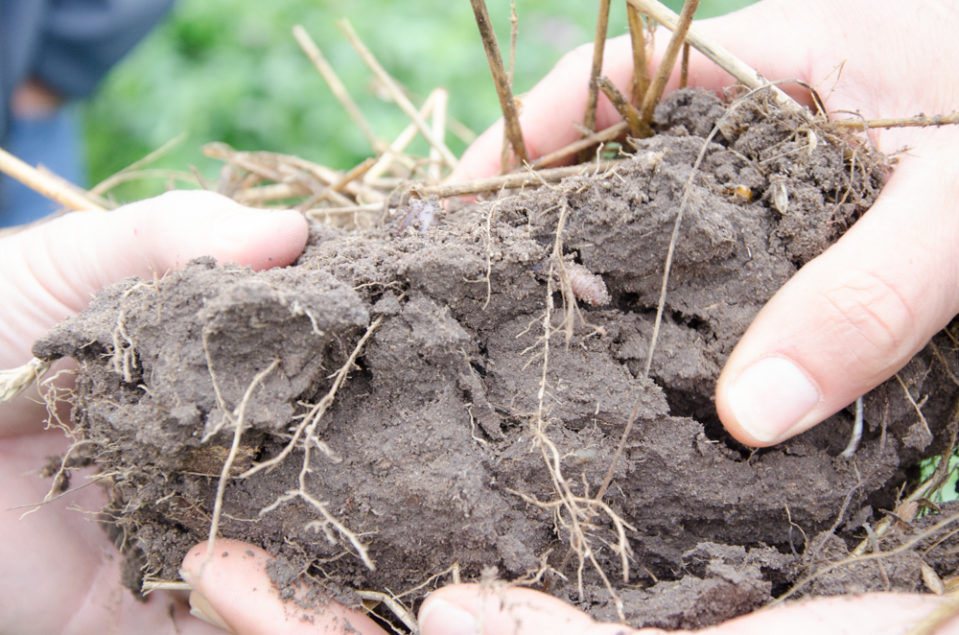
Can I increase soil organic matter by 1% this year?
By Sjoerd Willem Duiker
This fall, I participated in workshops where a farmer claimed that the organic matter in his soil was increasing by 1% per year. Is this a realistic goal to aim for?
The source of soil organic matter is photosynthesis which drives plant growth – either at root level or above ground. Therefore, the organic matter content cannot increase more than the amount of plant growth that can be produced in a year. Let’s just do some basic math assuming all plant matter is converted to soil organic matter. First, we need to know what an acre of soil can produce. Assume a very productive corn crop – producing 200 bushels per acre. That is 200 bushels per acre x 56 lbs/bushel x 0.845 (to correct for 15.5% moisture in grain) = 9,464 pounds of dry grain per acre. Typically, corn’s harvest index (the ratio of stalks to kernel) is 1, so the amount of residue produced is also 9,464 lb/A. The root mass produced by corn is on average 20% of the aerial mass, so if we add that that’s 11,357 lbs/A.
Better soils with the no-till system
Productive agriculture depends on healthy soil. Soil is a living ecosystem which ensures that nutrients are available in sufficient quantities during a plant’s life cycle and it retains water which is then available to plants. In this free publication from Penn State University, you’ll learn how you can protect this precious resource through no-till and understand the 14 spokes of managing and improving soil health. Download now “
Say you also grow a cover crop of rye and it ends up with 5,000 pounds of aboveground dry matter per acre and 1,000 pounds of belowground root mass. The total is 17,357 pounds of plant matter from corn and rye roots and stalks. Let’s convert all of this to carbon for accuracy. Stem carbon content is typically 40%, or 6,943 pounds of carbon produced per acre in roots and stems. Is that enough carbon to increase soil organic matter by 1%? Calculate the amount of carbon contained in 1% of soil organic matter. We assume that a one acre slice of soil (to a depth of 6.7 inches) weighs 2,000,000 pounds. So one percent of 2,000,000 is 20,000 pounds. Soil organic matter contains about 58% carbon. So one percent organic matter in the soil at a depth of 6.7 inches equals 11,600 pounds of carbon. That’s far more than the amount of carbon produced by a high yielding corn crop and a cover crop of rye!
I hope you will agree that this calculation shows that it is not possible to increase soil organic matter at the rate of 1% per year with current production constraints. And we haven’t yet included the conversion of plant residues into soil organic matter! This conversion has been shown to be only 10-20%. So if you add 6,943 pounds of carbon in the roots and stems of plants, that would only give 1,388 pounds of soil organic carbon or 2,393 pounds of soil organic matter. That’s 0.1% of 2,000,000 pounds of soil. Therefore, if you increase the organic matter content by 0.1% per year, you are doing a great job of management. Expecting a 1% increase is unrealistic.
This discussion assumes that there is no input of organic matter from other fields or farms. If manure or compost was applied, that would change the story. Fred Magdoff and Harold van Es include a calculation of the effect of spreading dairy manure on soil organic matter in the book “Building Soils for Better Crops (2nd Ed)”. They calculate that the application of 20 T/A/year of solid dairy manure would increase the organic matter content by 0.065% per year. So if we add relatively high manure applications to the equation, it might be possible to increase the organic matter content by 0.17% per year.
Incorporating a combination of no-till, cover crops, residues and manure can improve soil organic matter over time. We must be patient.
Hear Penn State University no-till and cover crop researcher Sjoerd Duiker discuss this thought-provoking topic of increasing soil organic matter in our latest no-till farmer Podcast.
Listen to part 1 now >>
Listen to part 2 now >>

Comments are closed.